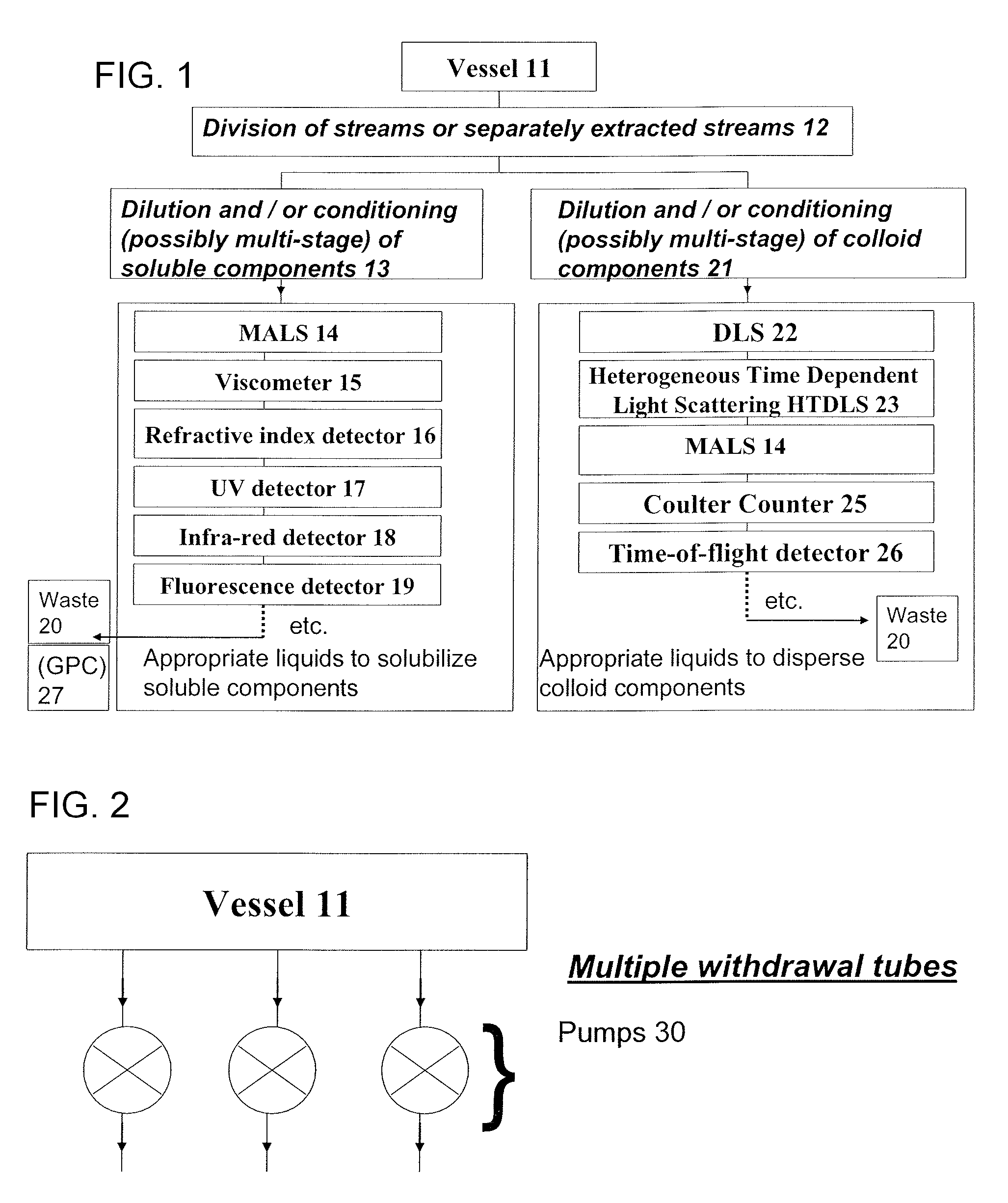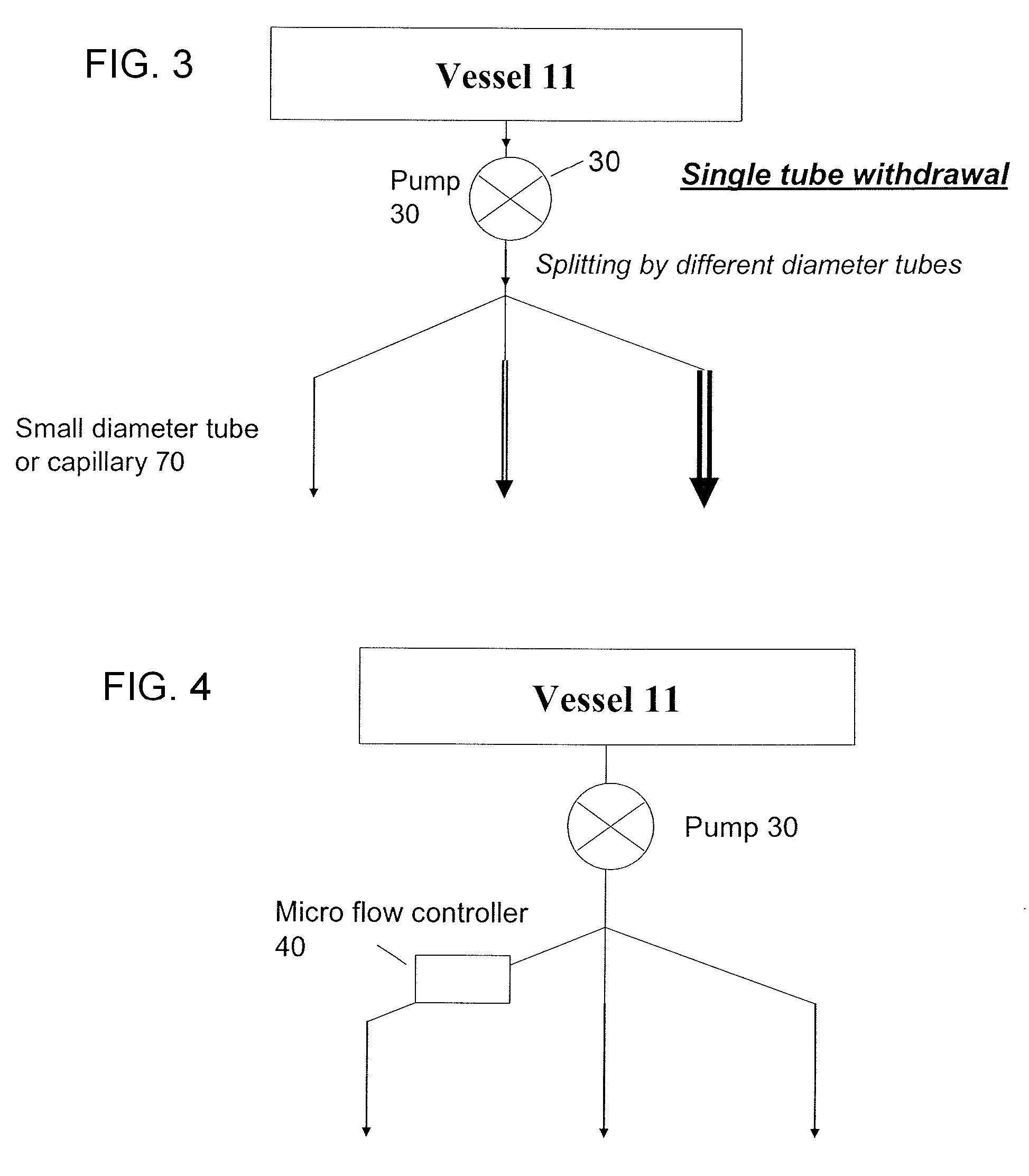Methods and devices for simultaneously monitoring the characteristics of microscopic particles in suspension and the characteristics of soluble components during reactions
a technology of soluble components and microscopic particles, which is applied in the direction of monitoring particle agglomeration, fluorescence/phosphorescence, instruments, etc., can solve the problems of affecting so as to facilitate the dispersion of particles
- Summary
- Abstract
- Description
- Claims
- Application Information
AI Technical Summary
Benefits of technology
Problems solved by technology
Method used
Image
Examples
experiment # 1
[0124]Experiment #1 is a case of surfactant-free emulsion polymerization of butyl acrylate BA. The very low BA solubility affects the initiation step of the reaction mechanism and hence, reaction kinetics. The PBA (polyBA—poly(butyl acrylate)) end products have higher molecular weight and viscosity than PMMA (polyMMA—poly(methyl methacrylate)).
[0125]Particle size measurements were made on the emulsion samples automatically and continuously withdrawn from the reactor 11 during the polymerization reaction using the extraction / dilution scheme shown in FIG. 7. The dilution in two stages of approximately 440× was made with H2O 50. The characterization measurement analysis produces a volume distribution (the volume proportion in each size class of the total volume of the particles) which is converted to a specific type of distribution (e.g. number, surface or length distributions).
Results for Reaction #1 (BA. No Surfactant)
[0126]FIG. 8 shows fractional monomer conversion and weight averag...
first embodiment
[0166]The following is a list of parts and materials suitable for use in the present invention:[0167]10 Apparatus of a first embodiment[0168]11 Reactor / vessel[0169]12 Division of streams or separately extracted streams[0170]13 Dilution and / or conditioning of soluble components[0171]14 MALS[0172]15 Viscometer[0173]16 Refractive index detector[0174]17 UV detector[0175]18 Infra-red detector[0176]19 Fluorescence detector[0177]20 Waste[0178]21 Dilution and / or conditioning of colloid components[0179]22 DLS[0180]23 Heterogeneous Time Dependent Light Scattering HTDLS[0181]25 Coulter Counter[0182]26 Time-of-flight detector[0183]27 GPC[0184]30 Pump (e.g. multi-head, peristaltic or separate)[0185]31 Fractionation system or batch techniques[0186]32 tee piece[0187]33 Detectors / detector train[0188]40 Micro flow controller[0189]41 Shimadzu pump 1[0190]42 Shimadzu pump 2[0191]43 Agilent pump[0192]44 Knauer pump 1[0193]45 Q pump 2[0194]46 Perist. pump[0195]47 Waters pump[0196]48 Eldex pump[0197]49 K...
PUM
| Property | Measurement | Unit |
|---|---|---|
| Polydispersity | aaaaa | aaaaa |
| molecular weight distributions | aaaaa | aaaaa |
| molecular weight distributions | aaaaa | aaaaa |
Abstract
Description
Claims
Application Information
 Login to View More
Login to View More - R&D
- Intellectual Property
- Life Sciences
- Materials
- Tech Scout
- Unparalleled Data Quality
- Higher Quality Content
- 60% Fewer Hallucinations
Browse by: Latest US Patents, China's latest patents, Technical Efficacy Thesaurus, Application Domain, Technology Topic, Popular Technical Reports.
© 2025 PatSnap. All rights reserved.Legal|Privacy policy|Modern Slavery Act Transparency Statement|Sitemap|About US| Contact US: help@patsnap.com



